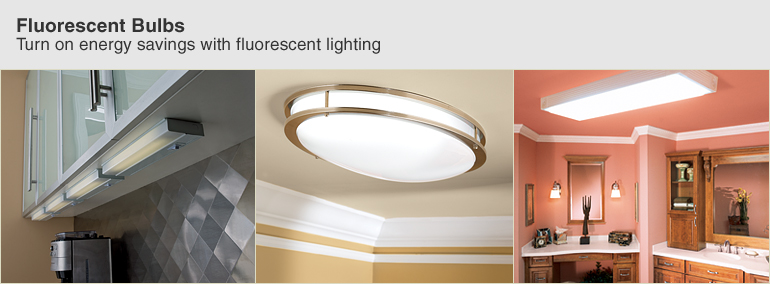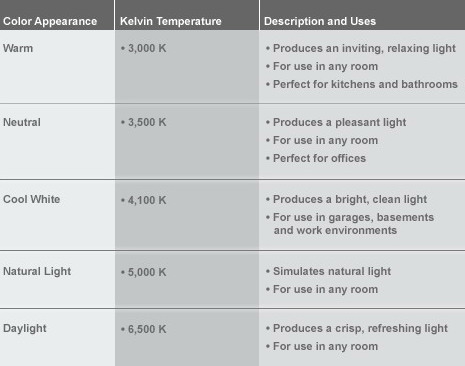Fluorescent lights are energy-efficient bulbs that use 20–40% less electricity than standard incandescent bulbs. Fluorescent bulbs come in a range of color temperatures, allowing you to customize the lighting in each room of your home. While some fluorescent bulbs feature the same screw-in design as incandescent bulbs, or LED light bulbs, not all are compatible with incandescent fixtures. Some fixtures may need updating before you switch to fluorescent lighting. This buying guide will help you understand what to look for when selecting a fluorescent bulb, so you can feel confident the bulb you choose provides the ideal lighting for any room in your home.

Factors to Consider
Fluorescent Lighting Options – Types and configurations, lumens and watts, color
Efficiency and Installations – Cost and savings, where to install
Fluorescent Lighting Options
Types and Configurations
Selecting a fluorescent bulb depends largely on the design of the light fixture you’re using. Fluorescent bulbs use either a pin-based design, specifically made to fit into fluorescent fixtures, or a screw-based configuration, made for fixtures designed for incandescent lights.
Tube fluorescent bulbs are ideal for large rooms or commercial installations. They come in linear, U-shaped and circline designs, with single, bi and 4-pin configurations. Tube fluorescent bulbs require an electronic ballast, a device that regulates the flow of electricity.
Linear tube bulbs range in length from 6–96”. Tube diameter is designated with a code, comprising a T (for tube), followed by a number indicating relative size. The standard tube sizes are:
T2 – 1/4” diameter tube, used in specialty fixture
T4 – 1/2” diameter tube, used in specialty fixtures
T5 – 5/8” diameter tube, used in specialty fixtures
T6 – 3/4” diameter tube, commonly used in retail displays
T8 – 1” diameter tube, commonly used in commercial buildings and some appliances
T9 – 1-1/8” diameter tube, used in machines and equipment
T10 – 1-1/4” diameter tube, used in homes and commercial buildings. T10 tubes are a high-efficiency bulb with high light output, designed as a replacement for the older, less-efficient T12 bulbs.
T12 – 1-1/2” diameter tube, used in homes and commercial buildings
Compact fluorescent light bulbs (CFLs) come in a range of shapes and sizes, making it easy to replace most incandescent bulbs with a CFL alternative. Screw-based CFLs fit standard incandescent fixtures and don’t require a separate ballast. Pin-based CFLs require fluorescent fixtures, which have a separate ballast.
Refer to our Compact Fluorescent Light Bulb Buying Guide for more information on CFLs.
Lumens and Watts
The amount of light the bulb gives off is measured in lumens, while the power is rated in watts. Lumens per watt is a way of identifying how many lumens a light source provides compared to the amount of energy, or wattage, used. Where incandescent lamps provide 17–20 lumens per watt, a fluorescent lamp delivers as much as 90 lumens per watt. To choose the most energy efficient bulb, check the lumens-to-watts ratio on the bulb’s packaging—the greater the lumens-to-watts ratio, the more energy efficiency the bulb provides.
Color
The color produced by a bulb is measured by the color-rendering index, or CRI. The scale runs from 1 to 100, with 100 being the equivalent of natural sunlight. Bulbs with a CRI of 70 give off the best quality of light.
The quality and tone of the color is measured in a temperature reading known as Kelvin. Higher Kelvin temperatures produce cooler shades. Refer to the chart below to determine the Kelvin temperature and color you prefer.

Efficiency and Installation
Savings and Cost
There are many advantages to using fluorescent lights in your home. First and foremost, fluorescent lights are energy efficient and help to promote a cleaner environment. While they may require a larger up-front cost, over time they save you more money because they last longer—as much as 8,000 to 15,000 hours—and help reduce your energy costs.
ENERGY STAR® rated compact fluorescent lights (CFL) offer a minimum efficiency improvement of at least 66% and last ten times as long as incandescent bulbs.
Lamps that use ENERGY STAR® CFLs operate at lower temperatures.
Some areas offer utility rebates for homes using fluorescent bulbs.
Where to Install
Install fluorescent bulbs in frequently used fixtures to maximize cost efficiency.
If you want to use a fluorescent bulb with a dimmer switch, make sure you choose a dimmable CFL. “Dimmable” will appear on the packaging for these bulbs.





